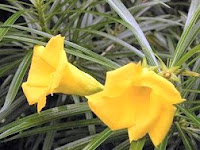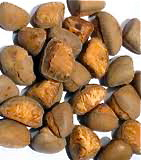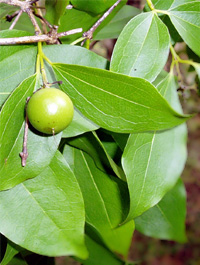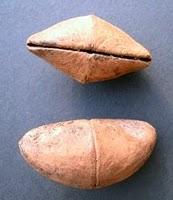Two different different plants share the name camalonga or cabalonga, the first term being more common in in Perú and the second in Colombia. The first of these two plants, sometimes distinguished as camalonga negra, apparently may be any of several species in the genus Strychnos, including some that are used in the manufacture of the arrow poison curaré. The second, sometimes distinguished as camalonga blanca, is pretty clearly Thevetia peruviana, the yellow oleander.
 |
| Camalonga blanca, yellow oleander (Thevetia peruviana) |
In Spanish generally, the word cabalonga refers to the almond-like seeds of the tree Strychnos ignatii, native to the Philippine Islands and China, which are popularly called haba de San Ignacio, St. Ignatius beans. In some parts of Perú, these seeds are worn as amulets, as they are in the Philippines, and the imported seeds are distinguished from the indigenous Amazonian species, cabalonga de la selva, jungle cabalonga. This imported cabalonga is apparently highly valued. The dried pear-shaped fruits containing these seeds are rare and, according to Christian Rätsch, are sold under the table at herb markets for exorbitant prices, with counterfeits sometimes substituted for the unwary.Interestingly, according to Rätsch, in Mexico, just as in the Upper Amazon, the word cabalonga is used to refer both to Thevetia peruviana and to a Strychnos species, Strychnos panamensis.
 |
| Seeds of Thevetia peruviana |
Apparently, Colombian shamans prefer to use seeds of plants of the Strychnos genus, while Peruvian shamans prefer to use the seeds of Thevetia peruviana. Peruvian shamans incorporate yellow oleander seeds into a drink, also called camalonga, along with aguardiente, camphor, and white onion or garlic. The drink generally contains two seeds, one male and one female. Although it is sometimes said that camalonga seeds may be added to the ayahuasca mixture, I have not found evidence that this is the case. In Perú, camalongueros are shamanic practitioners who specialize in the use of this camalonga drink.
I do not understand why the two camalongas are given the same name. The plants do not look even remotely similar, and the seeds — the part most often used by shamans — look as dissimilar as the plants. Moreover, the plants contain very different alkaloids, with very different psychophysical effects.
The yellow oleander contains the powerful cardiac glycosides thevetin, thevetoxin, peruvoside, ruvoside, and nerifolin, which are found throughout the plant, but are concentrated in the seeds. Ingesting yellow oleander seeds can cause abdominal pain, vomiting and diarrhea, dilated pupils, increased blood pressure, dizziness, stimulation of the smooth muscles of the intestine, bladder, uterus, and blood vessels, and a variety of arrhythmias, which can be fatal. Chewing the seed causes a drying, numbing, or burning sensation in the mouth and throat. The sap of the plant can cause skin irritation, sometimes blistering, and the plant has been used as a fish poison.
 |
| Strychnos toxifera, a typical plant of the Strychnos genus, an ingredient in the arrow poison curaré |
On the other hand, the primary effects of plants of the Strychnos genus are muscular and neurological. The active constituent of these plants is strychnine, which increases the reflex irritability of the spinal cord, resulting in a loss of normal inhibition of the body’s motor cells, in turn causing severe contractions of the muscles. Signs and symptoms of strychnine overdose include agitation, apprehension, fear, heightened startle reflex, restlessness, dark urine, muscle pain and soreness, and difficulty breathing, which can progress to rigid arms and legs, jaw tightness, painful muscle spasms, and finally to uncontrollable arching of the neck and back, respiratory failure, and brain death. Death is usually due to asphyxiation resulting from continuous spasms of the respiratory muscles. At very low doses, strychnine may give a sense of alertness, sensory acuity, and wakefulness; indeed, at one time it was widely prescribed in England as a tonic.
 |
| Seeds of Strychnos toxifera |
I have seen only scant anecdotal evidence that strychnine ingestion causes prodromal dizziness or lightheadedness. Thus, I am not sure what to make of the claim that true cabalonga can be identified by putting a tiny piece under your tongue and experiencing sensations of dizziness within a few moments.
None of the constituents of either type of camalonga has been reported to be psychoactive. Neither appears to be widely used medicinally. Strychnos guiananesis — called comida del venado, deer food — mixed with uña de gato, cat’s claw (Uncari spp.), has reportedly been used as a genital wash to treat venereal diseases, but its primary use is as an ingredient in curaré. At Takiwasi, a center in Tarapoto devoted to the treatment of addictions using traditional Amazonian medicine, camalonga — specifically identified as the seed of a plant in the Strychnos genus — is reportedly administered to newly admitted patients for ten days, combined with a sugar-free diet, in a program to detoxify certain unspecifed “energy disorders.”
Yellow oleander is used — as you would expect — as a purgative, and the leaves to treat toothache, presumably because of their numbing effect in the mouth. It is also considered an abortifacient, which is probably correct, given its stimulatory effect on the muscles of the uterus.
I would be very interested if anyone has any additional information on this topic.

- Previous Post: The Telepathy Meme
- Next Post: Peter Gorman on the Plant Spirits
- More Articles Related to: Plant Medicine, Sacred Plants, The Amazon



The seeds photos said tobe Strychnos nux-vômica are really from Thevetia peruvian.
Camalonga seeds like the upper pictures here published are subministered at the Mayantuyacu center to cure headaches: the internal par of one seed is cut thin and mixed with 2 liters of water. A small glass is taken twice daily, while concentrating on the icaro of the plant.
Thank you not only for this post but for creating this site in general. I am trudging through law school and its good to be able to have this “touchstone” to read, reflect on, and remember. you are doing a service. thank you.
The seeds of Camalonga Strychnos toxifera are grown in mexico and the south west and used in ceremony by hollowing them out and adding a seed or bb in it and tying them up around the ankles to make music and dance as well as rattles tied together, they are called ayoyotes and represent the snakes rattle and the earth as well as the seeds represent joy and happiness of the children
Hi, thanks for the article, one comment however, your pictures of the seeds are swapped around – Thevetia seeds are the triangular ones shown below, while the Strychnos seeds are in your picture at the top.
En el sureste Mexicano y particularmente en Tabasco , la Thevetia peruviana se conoce como Campana amarilla o copa de oro y es un alimento muy preferido por los Murcielagos y no le veo relacion con Strychnos toxifera, soy ambientalista y dia a dia compruebo que hay mucha confusion en la asignacion de nombres cientificos,acepto que el nombre comun puede ser multiple pero lo que no veo correcto es el nombre cientifico,que hacemos para mejorar esta situacion ?
I’ve taken camalonga in the Peruvian Amazon several times, and am starting regimen at home right now. In the Amazonian tradition, the camalonga seeds are macerated in sugar cane alcohol, with male and female camphor and wild onion. (This is NOT a pleasant-tasting mixture, to be sure!)
You drink what amounts to about a shot glass of the mixture before going to bed. The initial effects are a slightly light-headed sensation, but nothing too over-the-top. In my experience, there is no vomiting, pain, or any other unpleasant side effects. As you sleep, the camalonga straightens your energy and provides healing. It also facilitates lucid dreaming, and in your dreamspace, you can connect with powerful, guiding spirits.
I don’t recommend trying it for fun. It’s a serious shamanic practice that should be treated with the utmost respect. To that end, there are several dietary restrictions that must be adhered to during the times you consume camalonga.
hi, could you kindly provide the exact recipe amounts and the complete rules for dieting with camalonga?
Can you please provide the name of your shaman?
Camalonga is extremely powerful and well respected plant used for treating nervous system disorders, mental illness/weakness and so forth. Camalongeros are pretty rear type of shamans, not many ppl know how to handle Camalonga(same with Datura, Toecito). I would compare it’s effectiveness to ayawaska
hi, could you kindly provide the exact recipe amounts and the complete rules for dieting with camalonga?
I just diet 15 seeds of Thevetia peruviana in a 10 days diet, mixed with 5 ayahuasca ceremonies. Was very good, enhance mind clarity and energy level in general. I intake it as a concoction, was bitter, but not extremely bad. I had no counter effect that I could sense as well.
Here’s an article about the diet of camalonga that I did, and other plants during summer 2012.
http://xaviersaintcyr.com/index.php/the-amazonian-diet
Can you please tell me the foods that i should avoid if i start a camalonga diet. Thanks!